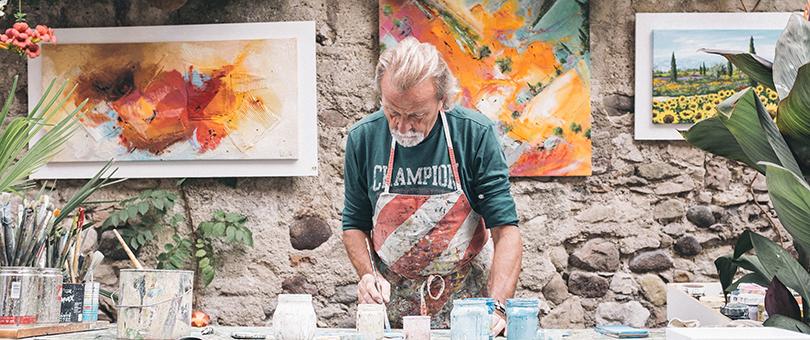When I graduated from art school 15 years ago, I had mastered color theory and watercolour techniques, but didn’t know the first thing about business. As a year-end project, we learned to create a very basic portfolio website. No ecommerce—simply samples of our work and a contact page.
My very first week as a proper adult and working artist, I learned a hard lesson: to succeed in art, you must also succeed in business. And my sad little Flash website wasn’t going to cut it.
I learned a hard lesson: to succeed in art, you must also succeed in business.
Ecommerce wasn’t as accessible 15 years ago, and social media was essentially non-existent. For unknown artists like me, the money was in corporate and advertising commissions.
The ability to easily sell your own art online completely changed the game.
In 2017, the starving artist is a dying breed. Ecommerce and social selling have become increasingly effective means for independent artists to self-sufficiently fund their craft, and most importantly, to gain the independence to sell the work they want to create directly to their niche audiences.
For galleries, the shift in the last two decades has allowed curators to represent more artists and expand into affordable prints to reach larger audiences worldwide.
How to sell art online
Since my own career as an illustrator lasted mere months, I consulted two Shopify merchants—an artist and a gallerist—actively making their living by selling art.
Maria Qamar, the artist also known as Hatecopy, quit her advertising career to focus on painting when her pop art Aunty paintings began to catch fire on Instagram.
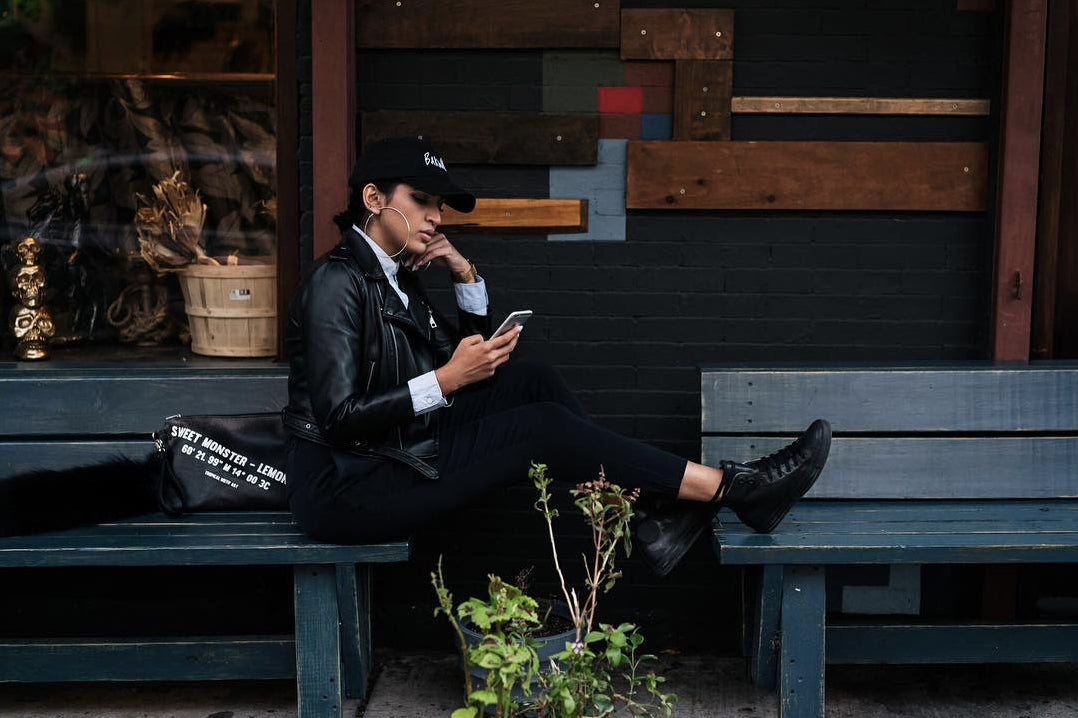
photo: Maria Qamar via Instagram
Ken Harman is the gallerist responsible for the Spoke Art empire—three galleries on two coasts, three ecommerce stores, a print shop and production facility.
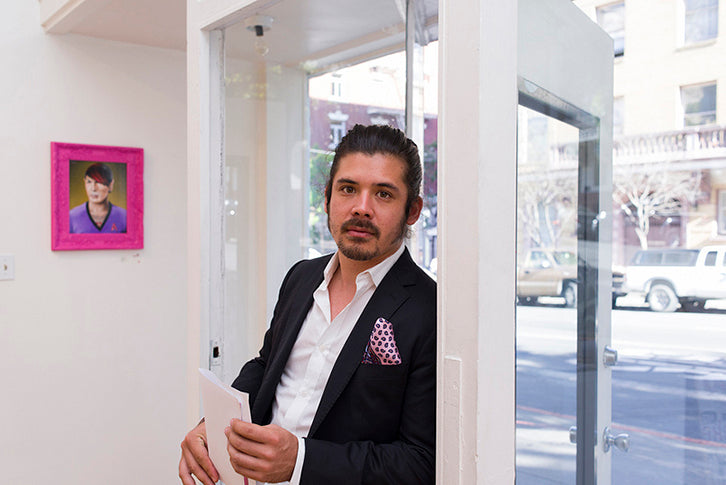
photo: Ken Harman, via Artistaday
Through Maria and Ken's personal experiences, we'll walk through the ins and outs of the business of being an artist, sharing their tips to help you sell art online.
Side hustle vs full time
Many new artists get their break on social, growing a devout following by sharing their work consistently and engaging in online artist communities.
Maria pursued her dream of becoming a working artist after being laid off from her advertising job, but the success didn’t happen overnight, and she supplemented her income in the beginning, while growing her fan base on Instagram.

“I did contract work here and there, obviously, because when you're starting out, you're earning zero dollars and zero cents.” – Maria
Her full-time job, however, taught her business skills that were critical in getting her store off the ground and marketing herself as an artist.
💡 TIP: Tap into employer resources and learning opportunities while you’re still working, growing your art business on the side. What knowledge or experience can you glean from your day job?
There’s something to be said also for taking the plunge. When Ken, unable to secure a temporary pop-up space, signed a two-year lease on a space, the risky moved helped him quit his job waiting tables within a few months.
"In 2010, I curated an exhibition with an Australian artist. He mailed me a bunch of work. I rented a venue. He bought his plane tickets, got his hotel, and about two weeks before his show was set to open, the pop-up venue went out of business and was no longer available. This was before pop-ups became sort of a cultural thing. I couldn't find a gallery that would let me borrow their space for a short amount of time. Eventually I came across an empty resale space that was the perfect fit for the exhibition. However, the landlord wanted a two year lease. I really didn't have any other options. I just pulled the trigger.” – Ken

photo: Rob Williamson for Spoke
Selling your own work vs selling art by other artists
If you’re not personally an artist, you can still get into the game of selling art as a curator. Artists disinterested in the business aspect of their craft rely on agents, galleries, and other merchants to do it for them.
There are several ways to work with artists, from selling originals or prints, to licensing works to be printed on merchandise. Generally, the artist would make a set commission on sold works.
"Most galleries offer an industry standard fifty percent consignment split for original art. The artist provides the artwork, we do our best to sell it, and then we split the proceeds fifty percent. For prints, we actually run our own print shop in Berkeley, California. We do all of our own printing in house. Typically we offer a fifty percent split after the cost of production.” – Ken
While Maria runs her own shop, where she sells prints and merchandise, eliminating the middle man and keeping her costs low, she leans on relationships with experienced galleries to exhibit and sell her original art.
Galleries can expose your work to new audiences, and have access to resources and professionals to help promote, handle, and ship artwork.
What to sell: original vs reproduction
Some mediums like sculpture are more difficult to reproduce or use for merchandise applications (but consider 3D printing or collaborations with toy manufacturers). Most 2D mediums, however, have multiple options for generating unlimited sales on a single work.
Consider the following:
- Original fine art
- Limited or open edition prints–giclee (framed or unframed) or canvas
- Digital downloads–desktop wallpaper, stock photos, inspirational quote prints, etc.
- Custom/commissions–original works in traditional or digital mediums
- Merchandise–hats, mugs, t-shirts, enamel pins, etc.
- Repeat prints on fabric or wallpaper
- Licensing work to other ecommerce merchants
- Collaborations with merchants and creators
In addition to selling prints and other merch on her site, Maria collaborated with Shopify merchant Nuvango to reproduce some of her works and prints on clothing.
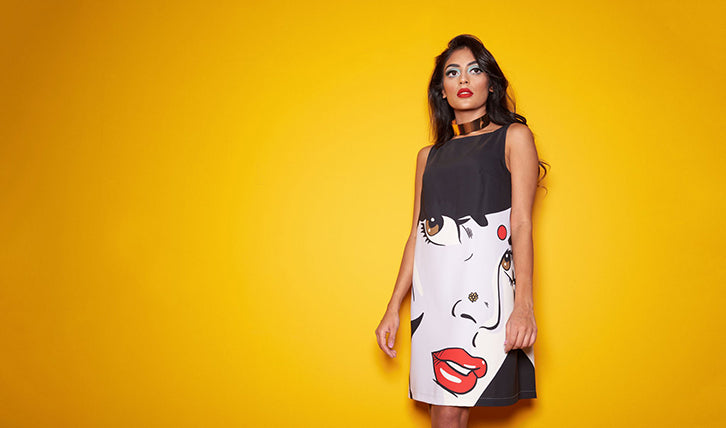
photo: Nuvango
Your online store
First, take a few minutes to create your store. Go ahead, I'll wait. We’ll let you play around for 14 days before committing to a plan.
When setting up your online art store, choose a theme that lets your art breathe–large images and lots of white/negative space. Add on apps that help you run your store more effortlessly, allowing you to focus on the creative aspects of the business.

Theme suggestions for art stores:
Apps to help run your online art business:
If you sell your artwork via prints and merch, apps like Kite, Gooten, or Printful can sync with your store, taking the burden of shipping and fulfillment out of the equation.

Printful catalog of products
“I use an app to do the printing and delivering. All I have to do is upload and let it do the work for me. Now I can focus on actually creating the artwork rather than printing, packaging, shipping every single day, spending at least three, four hours just doing that. I can now use that time to brainstorm and come up with better things and connect with people." – Maria
Now I can focus on actually creating the artwork rather than printing, packaging, shipping every single day.
Try apps like Photo Gallery to feature past or out-of-stock works—they can serve as a portfolio for galleries for other merchants looking to work with you, and requiring a full representation of your catalog.
💡 TIP: Use variants in Shopify to provide customers not only with size options, but finish and framing options as well. Variants can be edited to reflect unique/tiered prices.

Photographing and scanning art
Photographing and representing your products clearly and accurately is important across the board in ecommerce, regardless of industry. Without the ability to feel a product, customers need to get the best sense of what they’re buying through clear and detailed images.
“Ultimately when you're selling works online, it's all about the image. If you have a bad image of your work, the image that you have doesn't represent the work accurately, you're going to have a harder time selling it.” – Ken

Free Guide: DIY Product Photography
Learn how to take beautiful product photos on a budget with our free, comprehensive video guide.
Get our DIY Guide to Beautiful Product Photography delivered right to your inbox.
Almost there: please enter your email below to gain instant access.
We'll also send you updates on new educational guides and success stories from the Shopify newsletter. We hate SPAM and promise to keep your email address safe.
Photographing art is a little trickier than shooting other products, and a basic light setup may still cause glare or color irregularities. Consider hiring a professional to shoot larger works or art with any three-dimensional elements.
For 2D works, however, Ken recommends scanning as an affordable and effective alternative to photography:
"We have a photography setup at our production facility. However, the artists provide the scans of their own work, because scans are something they need for their own archives. The most cost effective way to do that is to get a desktop scanner and scan the work in parts and stitch it together in Photoshop. If you've got a piece that's got a high gloss coating or a resin, that's a little tricker, but for the majority of works on canvas or paper, it's pretty easy.”
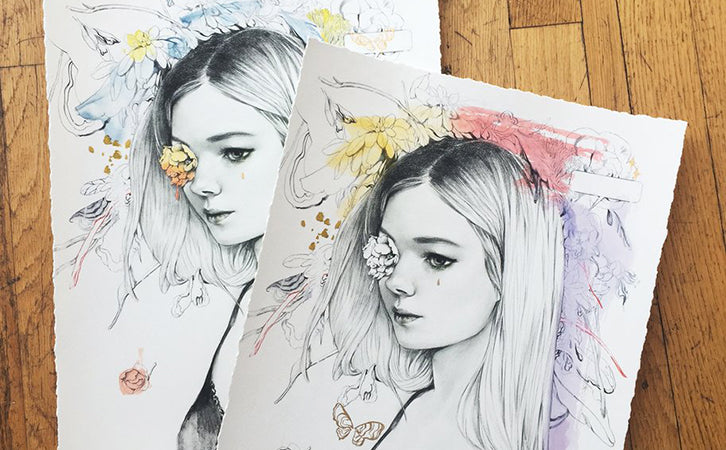
Helice Wen, via Spoke Art
Open vs limited edition
Reproducing work on t-shirts or mugs means that a single work can bear fruit indefinitely. However, some galleries like Spoke, opt for a limited edition model on many of the works they represent.
The effect is much like that of a limited time offer—creating a sense of scarcity and urgency is an excellent marketing tactic. For Ken, however, the decision to limit print runs goes deeper:
"We work really hard to find things that are very special to sell. Things that are special should be treated like they're special. While we may be able to make more money selling things as an open edition and selling as many as we possibly can, I think that by offering our works as limited editions really helps add to the value of the art.”
Offering our works as limited editions really helps add to the value of the art.
Limited edition has its drawbacks, however.
“A lot of the things that we sell have secondary market values. You can go onto a website like Ebay and find those works selling for in some cases, exponentially more than the original price, because the demand is so high. It’s certainly a little bit of a bummer, because we can't give all of our art to everyone who wants it.” – Ken
To help minimize reselling, Spoke will limit quantities of certain prints per customer. They’ve also built a blacklist of known resellers.
"Making sure that the real fans are actually the ones who are able to get the things that we sell is always a priority.” – Ken
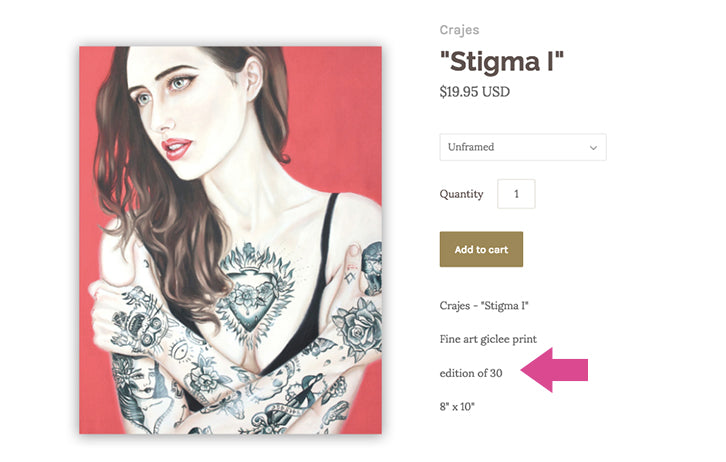
Printers and printing
It’s possible to create quality prints yourself with the right paper, ink, and printer. You can also offer your customers framed options, and DIY the framing. As a new artist, this method can keep costs low, but it’s not sustainable or scalable.
"In the beginning, I would print, package, and deliver by hand every single poster that was ordered. I did this for about 1,000 orders. Every morning, I would get up, go to the print shop, package all the prints, go to the Canada post office. At some point the volume became so much that I couldn't make time to draw or to be an artist. I was just spending all of my days delivering, and in transit.” – Maria
A local or online print company can reproduce your work en masse at wholesale prices, if you plan to do your own shipping or want to sell your prints offline, too.
💡 TIP: For a completely hands-off approach, look for a print on demand and dropship company. Maria now uses Printful for her online store.

Gallery shows, pop-ups, and offline events
Because Maria works frequently in traditional mediums, much of the impact of the texture and scale of her work gets lost digitally.
“It's actual physical work, so when we do exhibits, you can walk into a gallery and see that I'm a real person that has technical skills that can do paintings and large scale installations.” – Maria
Artists can also connect with fans and find new audiences by taking work offline. Use in-person experiences to drive people back to your online store.
Consider the following:
- Partner with a gallery to exhibit work
- Look into local art markets and events, set up a one-time or semi-permanent booth
- Consign work through gift or lifestyle stores, or set up a small pop-up within an existing store
- Open your studio to the public when you launch your website, or keep consistent weekly open-studio hours
- Run a pop-up shop (partner with other artists to reduce costs)

photo: Spoke Art
💡 TIP: Sync your online and offline sales by using Shopify POS for in-person selling.
Before Ken opened his permanent gallery, he dabbled in pop-ups as a means to build his reputation as a gallerist and validate the business idea, but has never let go of the physical part of the business.
“It's very rare to find a successful art gallery that functions entirely online. That really doesn't happen much and I think that a lot of the reason is people do want to see it in person. People also want to know that it's been seen in person as well.” – Ken
Working with galleries
If you’re interested in having your art represented by a gallery in addition to selling prints on your own site, do your homework and be professional, says Ken:
- DO check out the gallery’s social media accounts: “If you have more followers than that gallery does or that gallery doesn't have a lot of followers, that may give you pause.”
- DON’T approach a gallery via social media: “You'd be amazed at how many people try to submit to us via Facebook Messenger or tag us in a post on Instagram and ask us to look at their work. While social media is a major focus for us, that's just not a very professional way to come across if you're an artist.”
- DO your research and contact only those galleries who represent work in line with your own style: “You can't sell street art to somebody who collects impressionism.”
You can't sell street art to somebody who collects impressionism.
- DON’T spray and pray: “What's really frustrating is sometimes we'll get tagged in a post on Instagram and an artist who's hoping to catch our attention tags us and then tags twenty other galleries all in the same post.”
- DO send a personalized message in a professional email: "If you can find out the name of the director of the gallery or the curator for that gallery, being able to personalize an email is a great first step in that process.”
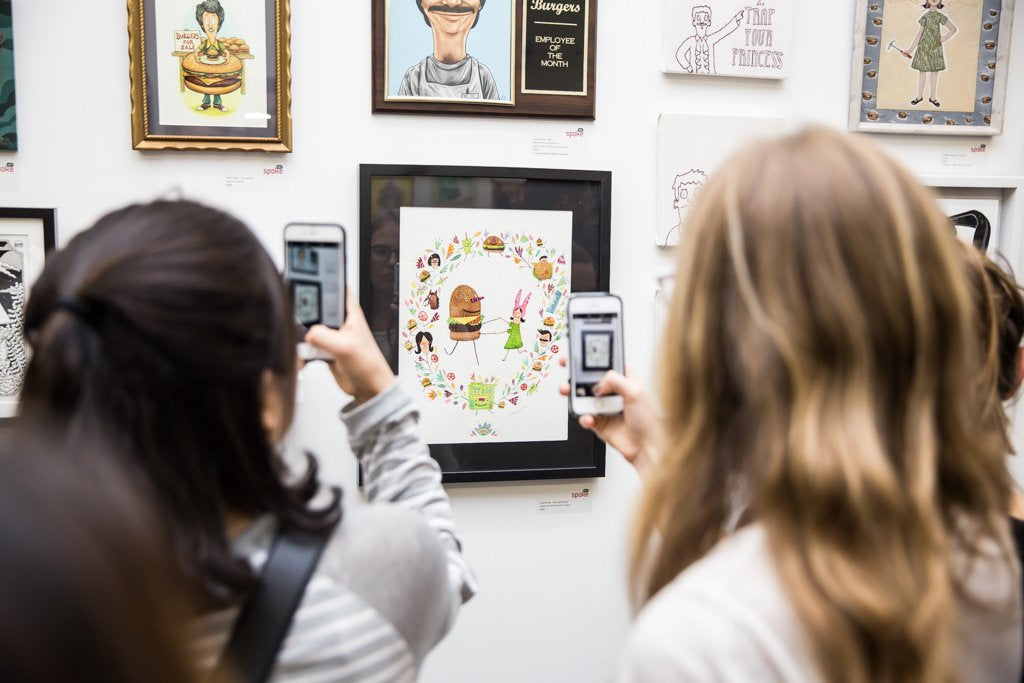
photo: Joe Russo for Spoke
Packing and shipping art
If you are shipping original art, or elect to ship prints and canvases yourself, rather than through a print and fulfill company, take extra precaution with your packing.
Prints and posters are best shipped in cardboard mailing tubes, and smaller prints in rigid cardboard mailing envelopes. Use glassine (a water and grease-resistant paper) or clear cellophane sleeves to protect prints within the packaging.
Framed works and canvases require additional precautions. The UPS Store and packaging supply shops like Uline and The Packaging Group offer packing and shipping materials like cardboard corners and specialty box sizes designed specifically for art.
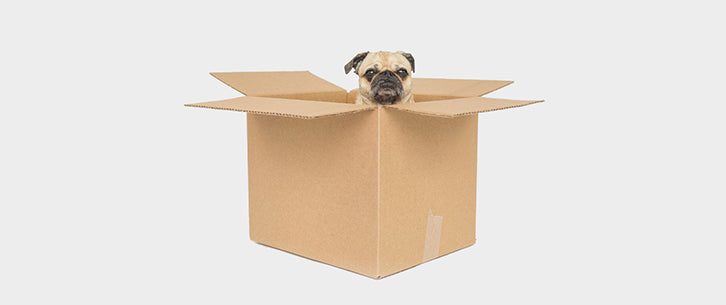
Resources:
- How to Ship Paintings: A Step-by-Step Guide for Artists and Galleries
- Shipping & Fulfillment 101: A Step-By-Step Guide for Getting Your Products to Your Customers
"There are a lot of little tips and tricks that can help keep shipping lower for art collectors. For example, the cost to ship a large painting that's stretched on a canvas can be pretty substantial, especially if you're getting into oversized dimensions. Sometimes what we do is unstretch a canvas, roll it in a tube, and ship it that way, which dramatically lowers the freight costs for the customers. Then they can have the canvas stretched locally.” – Ken
Shipping Insurance
Insurance is important when shipping original works, as a lost or damaged package can’t be simply replaced.
Many standard carriers like FedEx and USPS offer fairly basic insurance on most packages, and merchants should look into the specific extra coverage costs and limitations of each carrier’s insurance offerings. For higher value pieces, Ken takes additional measures to ensure the safety of the work.
“Shipping anything more than a thousand dollars is definitely tricky. You’re looking at something that's pretty valuable and going through a private freight company or art handling company financially makes sense.” – Ken
Plagiarism issues and copyright protection
Artist Tuesday Bassen waged war on copycats—large chain stores who ripped off her original designs–by hiring a lawyer and taking her story to the media.
For both Maria and Ken, however, copycats and plagiarism, they say, are just an unfortunate reality of doing business. Maria took legal action only once, before shifting her perspective:
“At the end of the day, it took me my whole life to learn how to do this. It took years and years of practice and discipline and a career in advertising, then unemployment to shape me into who I am. The technical skill that’s required to do what I'm doing can't be learned overnight. If somebody is copying me, they're going to have to sit down and eventually learn for themselves because sooner or later you're going to run out of ideas. If I don't put out anything, what's there to copy?”

Hatecopy
Maria takes Hatecopy’s copycats as an indication that she’s on to something.
“It’s a sign that I'm inspiring others and that what I'm doing is right because they wouldn't copy me otherwise. I'm not offended or bothered by it anymore.” – Maria
It’s a sign that I'm inspiring others and that what I'm doing is right because they wouldn't copy me otherwise.
For galleries like Spoke that represent multiple artists and sell art online, copycat websites are a consistent problem.
"We do have an issue with various online sites just bootlegging what we do. It's actually really become depressing, especially in the last few months. It happens in any industry, whether it be iPhones or apparel or concert tickets, so it's part of the way the world works unfortunately. We do do our best, but it happens.” – Ken
💡 TIP: Artists do have legal recourse, and should seek the advice of a copyright lawyer to help protect intellectual property before the infringement happens.
The artist as an entrepreneur
Growing your business as an artist means constantly creating new work to keep your fans as repeat customers. To do that, says Maria, you have to stay inspired:
“It's good to see the world from other perspectives. It helps you form your own opinions as to what you like, what you don't like. One of the things I always like to do is take a person to an art gallery that wouldn't normally feel comfortable going on their own. Everybody looks at art differently. Always be going to new exhibits, just to open your mind and look around and see how somebody else looks at the world. It can make you think a little bit differently about your own point of view.”

photo: Vice
Ultimately, artists are entrepreneurs by default, and embracing the non-creative aspects of the business is essential to success and growth.
“You could know everything about business and you could know everything about art, but ultimately it's the combination of both that really makes a successful store, makes a successful brand. That's what I am obsessed with creating, is that balance, that harmony between creativity and business.” – Maria
That's what I am obsessed with creating, is that balance, that harmony between creativity and business.
